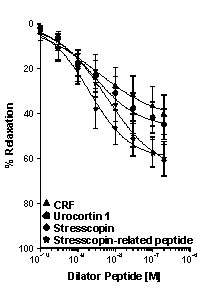| pA2
online © Copyright 2003 The British Pharmacological Society |
029P
University
of Manchester Autumn Meeting September 2003 |
|
K. E. Wiley & A. P. Davenport. Clinical Pharmacology Unit, University of Cambridge, Level 6, Centre for Clinical Investigation, Box 110, Addenbrooke's Hospital, Cambridge, CB2 2QQ, U.K. |
Print Abstract Search PubMed
for: |
Corticotropin releasing factor (CRF) and urocortin 1 produce a hypotensive response in man. Both peptides can activate CRF receptors and we have localised the novel CRF2 subtype to the human heart and vasculature using the selective radioligand [125MI]-antisauvagine 30 (Wiley & Davenport, 2003). Recently, two additional peptides, stresscopin and stresscopin-related peptide have been paired to CRF2 using reverse pharmacology and these ligands may mediate the 'stress-coping' effects of the CRF receptor system in the periphery. The aim of this study was to investigate if these peptides are vasoactive in human arteries in vitro.
Internal mammary arteries were obtained (with local ethical approval) from 13 coronary artery bypass patients (mean age 55 years, range 36-68 years). Isometric tension was measured in endothelium-denuded rings (3mm) maintained in oxygenated Krebs' solution. Segments were left to equilibrate to 37°C for one hour before tension optimisation. The maximal contractile force of each tissue was determined with 100mM KCl. Sub-maximal constrictions were then induced with 10nM endothelin-1 (ET-1) and cumulative concentration-response curves to CRF, urocortin, stresscopin and stresscopin-related peptide (0.1nM-300nM) were constructed. Control rings of vessel were constricted with 10nM ET-1 and the response measured over the time-course of the experiment. Not all rings responded to the peptides and the number of individuals, n, was expressed as responders/total tested. Results of responders were expressed as % relaxation of the constrictor response to ET-1 (mean ± s.e.mean). pD2 values for each curve were determined using iterative curve fitting software (Fig P.; Biosoft, Cambs, UK) and were expressed as mean±s.e.mean.
All the CRF receptor ligands tested reversed constrictions to ET-1with nanomolar potency (pD2 values: CRF; 8.28±0.27, n=8/8, urocortin 1; 8.39±0.32, n=7/8 stresscopin; 8.61±0.25, n=7/9 stresscopin-related peptide; 8.27±0.17, n=8/10, Figure 1). Stresscopin and stresscopin-related peptide both produced a greater maximum response than CRF or urocortin (EMAX: stresscopin; 61±7.2%, stresscopin-related peptide; 60±8.5%, CRF; 40±10% and urocortin; 46±7.7%).
Figure 1. Cumulative concentration-response curves to CRF and related peptides in human internal mammary artery.

The peptides produced vasodilatation in human arteries via an endothelium-independent action on the vascular smooth muscle. The maximum responses and potencies were comparable to those we obtained with established vasodilators such as adrenomedullin and CGRP (Wiley & Davenport, 2002), hence the peripheral CRF receptor system could be exploited as a new therapeutic target in the treatment of hypertension.
Wiley,
K.E. & Davenport, A.P. (2003) Br J Pharmacol In Press.
Wiley, K.E. & Davenport, A.P. (2002) Br J Pharmacol 136,
1146-1152.